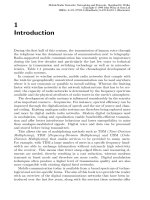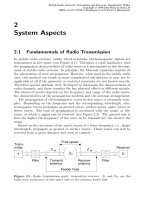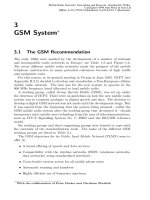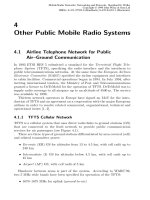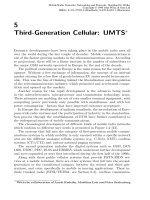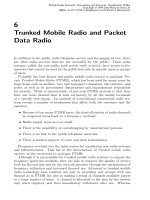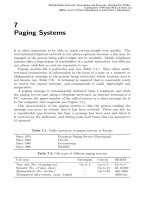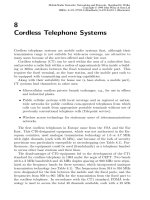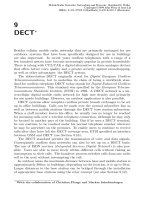Tài liệu Điện thoại di động mạng lưới Radio P1 doc
Bạn đang xem bản rút gọn của tài liệu. Xem và tải ngay bản đầy đủ của tài liệu tại đây (4.25 MB, 26 trang )
1
Introduction
During the first half of this century, the transmission of human voice through
the telephone was the dominant means of communication next to telegraphy.
Radio-supported mobile communication has constantly grown in importance
during the last few decades and particularly the last few years to technical
advances in transmission and switching technology as well as in microelec-
tronics. Table 1.1 presents an overview of the chronological development of
mobile radio systems.
In contrast to wireline networks, mobile radio networks that comply with
the wish for geographically unrestricted communication can be used anywhere
where it is not economic or possible to install cabling. Whereas the limiting
factor with wireline networks is the network infrastructure that has to be cre-
ated, the capacity of radio networks is determined by the frequency spectrum
available and the physical attributes of radio waves in the earth’s atmosphere.
The development of radio systems is influenced considerably by the scarcity
of an important resource—frequencies. For instance, spectral efficiency can be
improved through the digitalization of speech and the use of source and chan-
nel coding. Existing analogue radio systems are therefore being replaced more
and more by digital mobile radio networks. Modern digital techniques used
in modulation, coding and equalization enable bandwidth-efficient transmis-
sion and offer better interference behaviour and lower susceptibility to noise
than analogue-modulated signals. Digital voice and data can be processed
and stored before being transmitted.
This allows the use of multiplexing methods such as TDM (Time-Division
Multiplexing), FDM (Frequency-Division Multiplexing) and CDM (Code-
Division Multiplexing) that enable services to be provided to many users.
For example, with TDM a large number of users in a specific frequency band-
width are able to exchange information without extremely high selectivity
of the receiver. This means that fewer steep-edged filters and resonating el-
ements are needed, thereby resulting in a cost reduction, whereas modems
transmit in burst mode and therefore are more costly. Digital modulation
techniques often produce a higher level of transmission quality and are also
more compatible with existing digital fixed networks.
Mobile communication today is available from a broad spectrum of techno-
logical and service-specific forms. The aim of this book is to provide the reader
with an overview of the digital communications networks that have been in-
troduced over the last few years, along with the services these networks offer
Mobile Radio Networks: Networking and Protocols. Bernhard H. Walke
Copyright © 1999 John Wiley & Sons Ltd
ISBNs: 0-471-97595-8 (Hardback); 0-470-84193-1 (Electronic)
2 1 Introduction
Table 1.1: Chronological development of mobile radio systems
Year Paging
system
standards
Cordless
phone
system
standards
Mobile
terrestrial
system
standards
Mobile
satellite
system
standards
1980 POCSAG CT0 NMT 450 Nordic Mobile Telephone Inmarsat-A
1985 CT1 AMPS (USA) Advanced Mobile
Phone System
RC2000(F) Radio Communication
C450 (D,P) Cellular
TACS (UK) Total Access Commu-
nication System
Inmarsat-C
1990 CT2 GSM Global System for Mobile
Communication
DCS 1800 Digital Cellular System
at 1800 MHz
Inmarsat-B
Inmarsat-M
Inmarsat-
Paging
1994 ERMES TFTS Terrestrial Flight Telephone
System
1998 Inmarsat-P21,
Iridium, Aries,
Odyssey,
Globalstar,
Ellipso
2000 UMTS Universal Mobile
Telecommunication System
FPLMTS Future Public Land
Mobile Telecommunication System
2000+ Mobile Broadband System/
Wireless ATM
and their protocols. Special emphasis is given to systems in Europe that are
currently being used, are being standardized or whose introduction is immi-
nent.
Deregulation and liberalization of the telecommunications market, along
with the various agreements on standardization, are having a major effect
on the development of mobile radio systems. Detailed specifications are nec-
essary in order to achieve compatibility between the products of different
system and terminal suppliers. International and European standards bod-
ies are defining mobile radio systems that can be used and operated across
country boundaries. This will enable users to be reachable wherever they are
roaming and will result in the cost-effective production of terminals per unit,
thereby opening up the market to different types of customers. The most
important standards organizations active in the mobile radio area are covered
in Appendix B.
Physical connections over a radio channel are far more complex than those
in a fixed network. Some of the main characteristics of radio transmission are
therefore presented in Chapter 2.
4 1 Introduction
CT0
analogue
1984: CT1
analogue
1987: CT1+
analogue
Eurosignal
1974: 1989:
Cityruf
1990:
Euromessage
1989: Telepoint
analogue
1989: CT2
digital
1997:
ERMES
IMT 2000
1992: USDC
digital
1993: PDC
digital
1958: A-Netz
analogue
1972: B-Netz
analogue
1981: NMT
analogue
1986: C-Netz
analogue
1984: AMPS
analogue
1991: GSM
1994: DCS 1800
E1-Netz digital
1992: Data Radio
Modacom
INMARSAT-C
1988:
LEO Satellite Sys.
W-ATM
2000:1997:1996:
W-LAN 802.11 HIPERLAN/1
2002: UMTS
1991: DECT
digital
1991: Trunked Radio
analogue
1995: Trunked Radio
TETRA digital
Satellite Radio
Broadband Radio
Cellular Radio
Data Packet Radio
Trunked Radio
Paging Systems
Telephony
Cordless
1974: Private
MPT 1327Mobile Radio
D-Netz digital
1998: Iridium
Figure 1.2: Evolution of mobile radio systems (dates refer to introduction in the field)
1 Introduction 5
Table 1.2: An overview of analogue cellular mobile radio
Parameter C 450 NMT 450 NMT 900 TACS E-TACS AMPS
Original country Germany Scandinavia Scandinavia GB GB USA
Standardized by DBP Telekom CRAG CRAG FCC
Introduced in 1985 1981 1986 1984 1983
Uplink [MHz] 450.3–454.74 453–457.5 890–915 890–915 872–905 824–849
Downlink [MHz] 461.3–465.74 463–467.5 935–960 935–960 917–950 869–894
Channel spacing [kHz] 20 25 (20) 25 (12.5) 25 25 30
Duplex range [MHz] 11 10 45 45 45 45
Access method FDMA FDMA FDMA FDMA FDMA FDMA
Modulation FSK FFSK FFSK PSK PSK PSK
MAH
a
Yes No No No No No
Cell diameter [km] 15–40 2–20
Frequencies [#] 222 180 (220) 1000 1000 1320 833
(1999)
Data services [kbit/s] 2.4 – – – 2.4
(no HO)
Traffic capacity [Erl./km
2
] 14 14 12
(3 km distance)
a
Mobile Assisted Handover
6 1 Introduction
Figure 1.3: Distribution of analogue cellular systems in Europe
The concept of cordless communication systems summarizes services and
applications based on cordless telephony. In principle, with cordless tele-
phones, the cable between the telephone terminal and the handset was merely
replaced by a radio path that allows a radio connection of up to 300 m/50 m
(outdoors/indoors); see Chapter 9.
Wireless local area networks take into account the growing demand to avoid
cabling of workstation computers; see Chapter 12, whereas mobile satellite
radio systems provide global communication and accessibility; see Chapter 14.
The mobile communications market is currently developing at a rapid pace,
and it is anticipated that the next few years will bring a dramatic growth in
the number of users and an increased demand for quality. As a result, the
standardization bodies are already developing new standards with the aim of
providing a universal, service-integrated mobile telecommunications system in
the near future; see Chapter 5.
1.1 Existing and New Networks and Services
1.1.1 GSM/DCS 1800 System
The spectacular growth of the GSM-based cellular mobile radio networks,
including networks based on the DCS 1800 standard, convey the impression
1.1 Existing and New Networks and Services 7
CITY
RUF
EURO
SIGNAL
CT0
CT1
CT1+
ARTS
IMTS
AMPS NAMTS
TACS
E
TACS900
NMT
B
C450
RC
2000
RMTS
CT2
CT2
plus
CT3
PHP DECT ERMES
Analogue
Digital
NMT
450i
D
AMPS
CDMA
?
PDCGSM
D
AMPS2
PCS
1900
PHS
1900
PCS
1800
DCS
UMTS
IMT 2000
US Japan
A
EuropeUS
CND
Cordless Telephony
Europe
Paging
ITA F D
FIN
NOR
SWE
D GB
Europe
PLMN
NMT
450
Figure 1.4: Overview of worldwide standards for mobile radio systems
that the essential development needed in this area has been accomplished
through the introduction of these cellular mobile radio networks. What one
forgets is that these networks have been designed as an “extension” of ISDN
to the mobile user, but only address the needs to a limited degree: instead
of two B-channels per user, only one with a considerably lower user data
rate (13/6.5 kbit/s for voice and 9.6 kbit/s for data) is available. Likewise
the ISDN-D channel has only been reproduced to a point: an X.25 packet
service (X.31) on the D
m
channel is not possible in GSM. The primary rate
connection (2.048 Mbit/s) available with ISDN does not exist. The situation
is a similar one with competing systems in the USA and Japan (see Table 1.3
and Figure 1.4).
A number of concepts of GSM 900/DCS 1800 systems will have to be devel-
oped further in order to head off the competitive pressure of other concepts
for cellular networks (UMTS, IMT 2000, Spread Spectrum CDMA) and to
provide better support to mobile image and data services. The anticipated
demand for ISDN-compatible mobile data services (64 kbit/s) is pressuring

